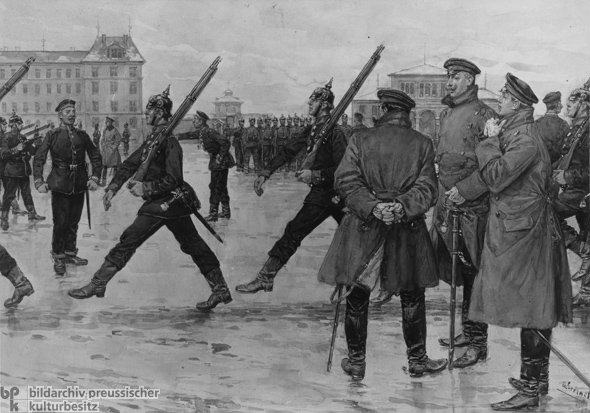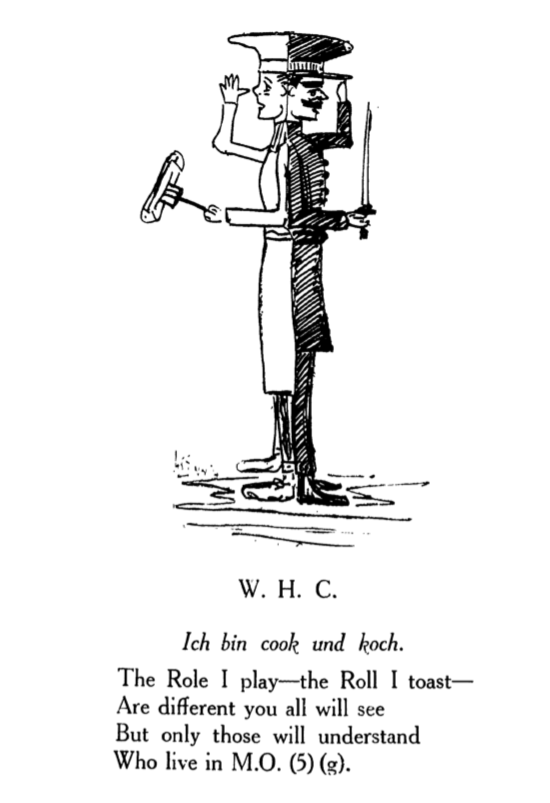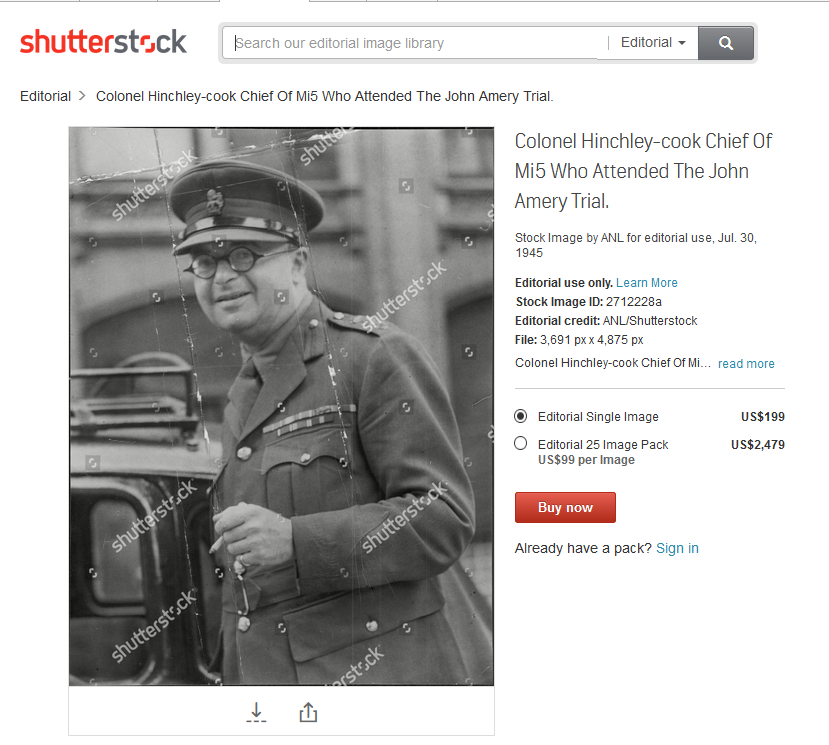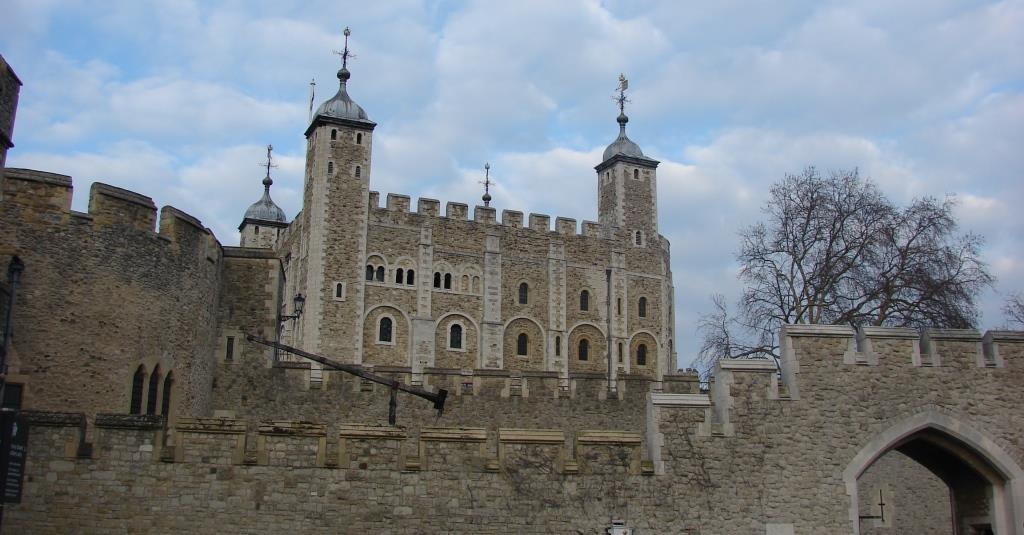I never really thought of MI5 as having a sense of humour. That was, until I received an email from Dr. Nicholas Hiley who kindly shared some MI5 cartoons from the First World War which seem to suggest that at least some of the MI5 officers had a sense of humour!
Nick had initially written to me because of his interest in the career of MI5’s Lt. Colonel W.E. Hinchley Cooke, a topic that I’ve blogged about before:
- 2016 – Breakthrough on Lt. Col. William Edward Hinchley Cooke
- 2015 – The Mysterious Origins of Britain’s WWII Spy-Catcher – William Edward Hinchley Cooke
- 2014 – Britain’s Spy-Catcher – Lt. Col. William Edward Hinchley Cooke
I shared the military personnel file on Hinchley Cooke with Hiley and, in return, Nick sent me a couple of MI5 cartoons from February 1915. The very idea that MI5 would even have cartoons is humorous in and of itself. But according to Hiley, there was quite a bit of cartooning in the MI5 office during the First World War. There were even two MI5 cartoon books that were privately printed and, from 1917 onwards, an annual MI5 Christmas/New Years card which often featured a cartoon.
The artist behind the two cartoons that Nick sent to me was drawn by Captain Hugh Steuart Gladstone (later “Sir Gladstone”), a Scotsman who had served with the King’s Own Scottish Borderers during the Boer Wars. At the outbreak of the First World War, Gladstone rejoined the KOSB and was Mentioned- in-Dispatches. He was, however, quickly snapped up by the War Office and joined the nascent MI5 office in 1914/15. In amongst his other duties, Gladstone put his artistic hand to work in drawing a number of cartoons and caricatures.
Mr. C[ooke] Joins the National Reservists

Caption reads “Mr. C. joins the National Reservists [or some such corps] but, unfortunately,
remembers his previous military training on his first day of instruction.”
Kindly shared with me by N. Hiley.
The cartoon depicts a British Non-Com pointing to a row of four National Reservists (or some such corps) while one soldier is clearly marching to a different drum. The caption notes that “Mr. C. … unfortunately remembers his previous military training on his first day of instruction.” Which got me wondering… would Hinchley Cooke have had previous military training, given his history?
A Conscripted Cooke?
Born in Dresden on 31 January 1894 to a British father and a German mother, Hinchley Cooke attended school in Dresden. Christopher Andrew, in his book on the history of MI5, notes that, after completing his schooling, Hinchley Cooke attended Leipzig University. But the average German male, after making his Abitur, would have faced the prospect of compulsory military service.
At the age of 20, all German men were conscripted into the Imperial German Army for two to three years. This was a daunting prospect for many young men who wished to attend university or perhaps get started in the family business. There was, however, another option. A young man could instead choose to become a One-Year Volunteer Enlistee (Einjährig-Freiwilliger). Volunteering for one year (instead of being conscripted for two to three years) had some obvious perks, one of them being that the young recruit could choose their military service branch and unit. On the other hand, the Einjährig-Freiwilliger also had to equip and support himself at his own cost (or that of his father) which was not cheap.
Let us, for the moment, presume that Gladstone was accurate, and that Hinchley Cooke had received previous military training. If he chose the Einjährig-Freiwilliger path, he might have entered the standard training period in November 1912 or 1913. After five months he would have been sent to his Regiment/Unit for the remainder of his service. If Hinchley Cooke chose to be conscripted at the age of 20 (31 January 1914), he might have squeaked in a few months of compulsory military training before the declaration of the First World War. Other evidence, however, suggests that Hinchley Cooke was working for the British Legation in Dresden in early 1914 and was deported to Britain at the beginning of the war. This would suggest that the Germans did not view Hinchley Cooke as a German citizen, which does make one wonder if he completed military service in Germany. Perhaps at all. Although, one then wonders at the following cartoon in which Hinchley Cooke is portrayed as marching differently during a “National Reservists” training period. Perhaps Gladstone was having a bit of fun at Hinchley Cooke’s expense.
The German Goosestep
Gladstone’s cartoon draws attention to the fact that Mr. C[ooke] is performing a different march from the other recruits, presumably a military one. Given that this is most likely a reference to the German military, one could think that Mr. C[ooke] was performing the goosestep. This march step was known as the Stechschritt (literally, “piercing step”) or Stechmarsch and originated in the Prussian military drill of the mid-1800s. German military advisors spread it to Russia in the 1900s and for there it spread around the world. It is often associated with the Nazi regime, but other totalitarian regimes have taken it on as well. It is hard to perform, brutally hard on the knee joints and is generally only used for ceremonial occasions.

Source – German History in Documents and Images
The only problem with the cartoon is… the goosestep is a march in which the soldiers extend their legs straight out and do not bend them at the knee. And yet, we have three of the soldiers doing what appears to be a low elevation goosestep while one soldier is bending his knee in a strange high step. Germany most definitely used the goosestep while England used a bent-knee style of marching, but neither used such a strange high step.
I’ve done a bit more research and came across some videos of pace-sticking by the British Army. The videos show soldiers doing a slow march with legs extended straight in front of them with what look like a low-elevation goosesteps. I also found one reference which said that Nazi soldiers were “high-stepping”, likely a reference to goose-stepping.
On the other hand, there is a high step march that is/was used by some military forces (e.g. Serbia), although Germany was apparently not one of them. The high step is similar to the goose step but instead of keeping the leg straight, the knee is bent at the top of the arc. Today, many marching bands in the USA perform various versions of the high step march.

This leaves me wondering if perhaps Gladstone wasn’t quite sure what a goosestep looked like, or perhaps had heard it called a high step, and drew accordingly. Or, perhaps… I am reading too much into a cartoon!
The obvious message in the cartoon is that Mr. C[ooke] had previous military training which wasn’t quite in step with the “National Reservists (or some such corps)”. If we presume that this is a British “National Reservists” training (as evidenced by the two (or three) chevrons on the corporal (or sergeant)), then clearly Mr. C[ooke] received his military training in another country, in this case, Germany. Unless of course, Gladstone was simply having some fun at the expense of Hinchley Cooke and his German background.
Cooke vs. Cook
The second cartoon, also drawn by Gladstone, also pokes some fun at Hinchley Cooke, using a play of words on his surname (Cooke vs. cook).

The caption reads:
W.H.C.
Ich bin cook und koch. (I am cook and cook)
The Role I play–the Roll I toast–
Are different you all will see
But only those will understand
Who live in M.O.5(g).
Kindly shared by N. Hiley.
The M.O.5(g) is a reference to the nascent MI5 office in which Cooke and Gladstone both worked. I am going to hazard a guess that this a reference to the times when Hinchley Cooke posed as a German soldier (Wilhelm Eduard Koch) in Prisoner of War camps. Given that he spoke perfect German, and perhaps had some military training, he would have blended seamlessly into the pool of captured German soldiers.

(From Defence of the Realm by Christopher Andrew)
I am left wondering how Hinchley Cooke took all of this good-natured ribbing. Perhaps he took it all in good stride. He was obviously committed to his British roots and was later known as fiercely anti-Nazi.
Another View of Hinchley Cooke
On a final note, I made a typo while searching for some information on Hinchley Cooke and entered “Hinchleycook” in error. Up popped this image from Shutterstock which I have never seen before. Fascinating! There aren’t that many pictures of Hinchley Cooke in existence, at least not for public viewing…
- a young Hinchley Cooke dressed up as a German soldier (image above)
- Hinchley Cooke dressed in civilian clothes while leaving a trail (published in Stanley Firmin’s They Came to Spy – although I believe it was originally published in a newspaper in the 1930s or 1940s)
- Hinchley Cooke sitting at a desk (published in After the Battle Magazine)

(From Shutterstock site)
Thus, this image below is quite a find. I’m curious to know the source of it. I am not familiar with the acronym “ANL”. The “read more” simply says (in its entirety) – “Colonel Hinchley-cook Chief Of Mi5 Who Attended The John Amery Trial.”
Hinchley Cooke passed away in 1955 of a sudden heart-attack.
Sources
The cartoons are sourced from an MI5 cartoon book, Leakages from Watertight House, published in London in 1916. The title of the book is a play words. At the time, MI5 was housed in Watergate House in the Adelphi. The second book, published in 1917, was titled Outbursts from Waterloo(se) House and is another play on words. In 1916, MI5 had moved to Waterloo House in Haymarket.
Sir Hugh Steuart Gladstone – Obituary
Military Wikia – German Imperial Army
Wikipedia – Einjährig-Freiwilliger

Hello – I am a journalist working on a historical research project. I am trying to reach your Dr. Nick Hiley, who you mention on this blog.
I am wondering if it would be possible for you to help me contact him please? It’s about some research he did into British intelligence.
I would be most grateful for your help
Regards,
Tristan Redman
Hi Tristan,
Thanks for the message. I’ve forwarded your request on to Nick Hiley.
Giselle